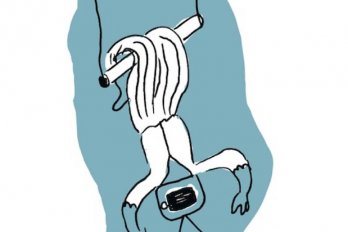It’s fall 2009, and the citizens of a country perpetually on the brink of an election pore over morning headlines announcing the latest political polls. Later in the day, some of the same people are stealing breaks from the daily grind to attend to a survey of a different order, posted on urtak.com: Would a fully-grown male moose beat Shaq in a fight? You may care less about your neighbours’ measure of the basketball star’s prowess (80 percent think the moose could take him) than, say, Stephen Harper’s. But Marc Lizoain, the co-founder of Urtak, would argue that the inquiry is equally valuable—because it comes from the people.
“It didn’t seem fair to me that only rich organizations could ask the questions,” Lizoain says of the impetus to build a site that invites users not only to respond to survey questions but to generate them: “It’s kind of contrary to the spirit of the times.” The twenty-four-year-old Toronto native is himself very much of the times, given to ironic facial hair and clever turns of phrase. When I visit him at Urtak’s headquarters in a converted industrial space in Manhattan outfitted with four Apple computers, a beanbag chair, and a whiteboard (“We’re a tech start-up,” he quips. “You have to have a whiteboard”), he says that while studying history at Harvard he came to believe that relevance is a matter of opinion—and opinion a matter of relevance. And so, shortly after graduating in 2007, he contacted former roommate Aaron Gibralter, and the pair started work on the online polling project that aims to democratize public opinion research.
Taking the Pulse
A list of poll questions from urtak.com
Terry Corrigan
Are Vegans annoying?
If you could choose a “re-do” for your entire life up to this point, would you?
Have you ever told someone on the phone you had to go do something, when you really just wanted to go watch TV in peace?
Are you lonely?
All things considered, is the Old Testament kind of silly?
Is one man’s terrorist another man’s freedom fighter?
Are you a little bit racist?
In a weird way, does it make sense to you that eating the heart of your enemy should give you their power?
Polling originated as a populist initiative in the early nineteenth century, when voters attending campaign events were haphazardly asked to indicate their allegiance with a show of hands. The first real player in polling history, however, was the Literary Digest, a US weekly that attempted to ascertain the public’s views on hot button issues via ballots mailed to millions of registered car and telephone owners, starting in 1916. Twenty years later, an Iowa advertising researcher named George Gallup used a method of polling much smaller but more demographically representative samples to correctly predict that Franklin Roosevelt would beat out Alfred Landon in the US presidential race. He also cheekily announced that the Digest would pick the losing horse weeks before it mailed out its ballots, establishing his approach as the gold standard in an industry that quickly gained ground.
However, pollsters have been having a hard time lately. Fewer households have land lines, particularly among young and lower-income cohorts, and participation rates across the board have plummeted: as few as 20 percent of Canadians will take a given telephone survey, down at least 50 percent from thirty years ago. The industry, it seems, isn’t quite sure how to solve this problem. Angus Reid Strategies, one of the largest Canadian-owned polling companies (and newly subsumed under Vision Critical), now conducts the bulk of its research online, culling respondents for specific polls from an Internet forum of tens of thousands of willing Canadians. But Frank Graves, head of competitor EKOS Research Associates, suggests that this method results in some self-selection bias. His firm has implemented a recruitment method that involves randomly calling and text-messaging cellphones.
Lizoain, of course, doesn’t think any of these strategies will fix what truly ails the industry—namely, that it costs thousands, if not millions, of dollars to commission a poll, and the private organizations that pay big bucks for research also get proprietary rights to the results. Urtak turns this power dynamic on its head. And although many of the 25,000-plus questions posted on the site are mere diversions, interesting only in principle, some have yielded compelling findings. Who would have thought that almost all the readers of James Patterson’s teen fiction count reading among their top hobbies? Or that 63 percent of respondents consider themselves addicted to something? Or that slightly fewer still think politics is a respectable career path?
Polls can only tell us what a pollster already knows, Lizoain explains. In other words, if a cop pulls you over and asks if you’ve been drinking, she won’t discover you’re woozy with prescription painkillers. By inviting the people about whom you’re curious to pose the questions, you increase your chances of illumination. But the professionals aren’t giving up just yet.
“Survey research should accurately mirror societal attitudes, values, beliefs, and behaviour,” Graves says. “If your mirror is distorted in unknown ways, then it’s not giving you an accurate reflection.” Urtak, in that case, is like the funhouse mirror. Questions can be ambiguous, double barrelled, or biased. Respondents are self-selected, making a random sampling almost impossible. Ultimately, there’s no way to tell whether the samples represent the views of the population at large. “Any jackass can go on the street and ask a question of ten people,” Angus Reid president Edward Morawski says, “but what does that mean, except for what those ten people think? ”
Lizoain and Gibralter are already working on a more sophisticated interface to analyze demographics and cross-tabulate results so you, too, can scrutinize the endless data. If the industry takes nothing else away from Lizoain’s experiment, it might take this openness, given the acknowledged difficulty of getting good samples in the Internet age. Indeed, a handful of pollsters have reluctantly credited Urtak for its commitment to transparency. But in the spirit of the times, perhaps you should decide: Are polls a good way to measure public opinion?





